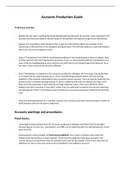Summary
Summary Accounts production guide.
- Course
- Institution
This guide includes the checklist and special steps involved in the preparation of financial accounts for the client. It is very useful for professionals in their early stage of career in the field of accountancy and want to learn how to produce accounts as quick as possible.
[Show more]



